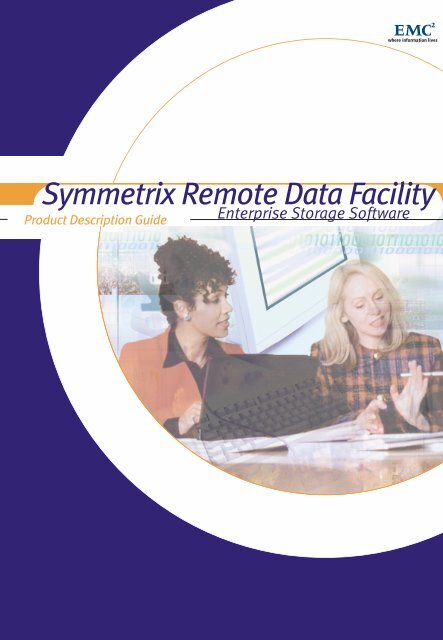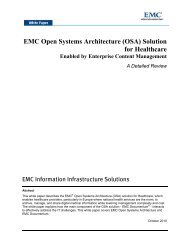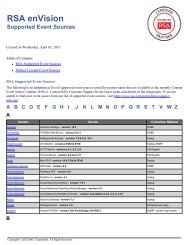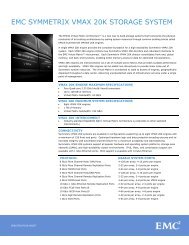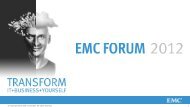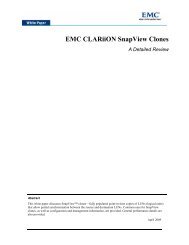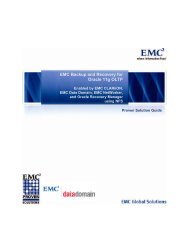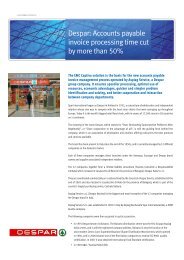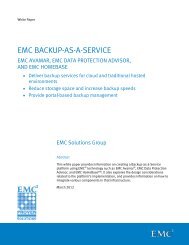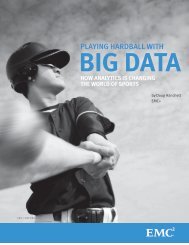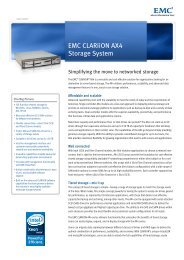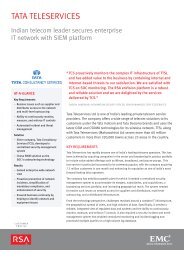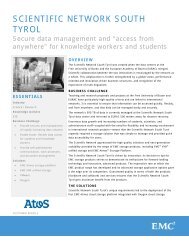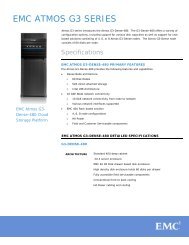Symmetrix Remote Data Facility (SRDF) Product Description ... - EMC
Symmetrix Remote Data Facility (SRDF) Product Description ... - EMC
Symmetrix Remote Data Facility (SRDF) Product Description ... - EMC
Create successful ePaper yourself
Turn your PDF publications into a flip-book with our unique Google optimized e-Paper software.
<strong>Symmetrix</strong> <strong>Remote</strong> <strong>Data</strong> <strong>Facility</strong><br />
<strong>Product</strong> <strong>Description</strong> Guide Enterprise Storage Software
SYMMETRIX REMOTE DATA FACILITY PRODUCT DESCRIPTION GUIDE<br />
<strong>Symmetrix</strong> <strong>Remote</strong> <strong>Data</strong> <strong>Facility</strong> (<strong>SRDF</strong>)<br />
<strong>Product</strong> <strong>Description</strong> Guide<br />
Table of Contents 3 Chapter 1: Introduction<br />
3 Overview<br />
3 The Value of <strong>Symmetrix</strong> <strong>Remote</strong> <strong>Data</strong> <strong>Facility</strong><br />
4 Business Impact<br />
4 Operational Impact<br />
5 Financial Impact<br />
5 <strong>EMC</strong>’s Architectures for Enterprise Storage: ISA and MOSAIC:2000<br />
6 Information Protection<br />
7 Information Sharing<br />
7 Information Management<br />
8 <strong>SRDF</strong> and <strong>Symmetrix</strong><br />
9 <strong>SRDF</strong> and Fibre Channel<br />
9 <strong>SRDF</strong> and IP<br />
10 <strong>SRDF</strong> and <strong>EMC</strong> TimeFinder<br />
10 <strong>SRDF</strong> and AS/400 Environments<br />
11 Chapter 2: <strong>SRDF</strong> Uses and Applications<br />
11 Overview<br />
11 Disaster Recovery, the Old Way<br />
11 Disaster Scenarios<br />
12 Disaster Recovery Sites<br />
12 Traditional Techniques for <strong>Data</strong> Recovery<br />
12 Store the Tape Copies at a Secure Site<br />
13 Create the Tape Copies at the Recovery Site<br />
13 <strong>Data</strong> Copies on Disk<br />
13 Using the Host/Server to Create the Copies<br />
13 Disaster Recovery Testing<br />
13 Business Continuity<br />
14 Eliminating the “Race to Sunrise”<br />
14 Loading <strong>Data</strong> Warehouses<br />
14 Scheduled Maintenance<br />
14 <strong>Data</strong> Center Migrations<br />
14 Workload Migrations<br />
14 AS/400 Applications<br />
16 Growing Your Business with <strong>SRDF</strong><br />
16 <strong>SRDF</strong> Over IP Optimizes Information Deployment<br />
16 <strong>SRDF</strong> Over Fibre Channel Increases Throughput<br />
17 Chapter 3: <strong>SRDF</strong> Detailed <strong>Description</strong><br />
17 <strong>SRDF</strong> Principles of Operation<br />
17 <strong>SRDF</strong> Hardware Components<br />
19 <strong>SRDF</strong> Implementation<br />
1
SYMMETRIX REMOTE DATA FACILITY PRODUCT DESCRIPTION GUIDE<br />
20 Installation and Planning<br />
20 Supported Environments<br />
21 Multihost Support<br />
22 <strong>SRDF</strong> Campus Solution<br />
23 <strong>SRDF</strong> Extended Distance Solutions<br />
23 <strong>SRDF</strong> FarPoint<br />
23 <strong>SRDF</strong> Multi-hop Capability<br />
24 <strong>SRDF</strong> over IP for Extended Distances<br />
24 <strong>SRDF</strong> Modes of Operation<br />
24 Synchronous Mode<br />
25 Semi-Synchronous Mode<br />
26 Adaptive Copy Mode<br />
26 Consistency Group Utility<br />
27 Domino Option<br />
27 <strong>SRDF</strong> FarPoint Option<br />
27 Invalid Tracks Attribute<br />
27 <strong>SRDF</strong> Management<br />
28 Chapter 4: <strong>SRDF</strong> Usability Considerations<br />
28 <strong>SRDF</strong> Features and Capabilities<br />
28 Sequential <strong>Data</strong> Updates Across the Link<br />
28 Local and <strong>Remote</strong> Mirrors of the Same Volume<br />
28 <strong>SRDF</strong> and RAID-S Compatibility<br />
28 Dynamic Sparing<br />
28 Source/Target Switching<br />
29 Source Control of Target<br />
29 HP MetroCluster<br />
30 Potential Events<br />
30 Local or <strong>Remote</strong> Volumes<br />
30 Link Breaks<br />
30 Return to Source Site<br />
31 Synchronization and Resynchronization<br />
31 Use of Track Tables<br />
32 Performance<br />
32 <strong>Data</strong> Recovery<br />
32 <strong>Data</strong>bases<br />
33 Backup Using <strong>Remote</strong> <strong>Data</strong><br />
33 Read-Only Access to Target Volumes<br />
33 <strong>SRDF</strong> Testing<br />
34 Chapter 5: <strong>Symmetrix</strong> Software Solutions and Service<br />
34 Software Solutions<br />
35 Professional Services<br />
35 Enterprise Business Continuity<br />
36 Enterprise Storage Architecture and Design ñ Building an E-Infostructure<br />
36 Enterprise Storage Network<br />
36 Support and Service<br />
2<br />
SYMMETRIX REMOTE DATA FACILITY PRODUCT DESCRIPTION GUIDE<br />
Chapter 1<br />
Introduction<br />
Overview This guide describes <strong>Symmetrix</strong> <strong>Remote</strong> <strong>Data</strong> <strong>Facility</strong>, <strong>SRDF</strong> , <strong>EMC</strong>’s industry-leading<br />
information protection and business continuity software solution for use with <strong>Symmetrix</strong> ®<br />
enterprise storage systems.<br />
Chapter 1 provides an overview of <strong>SRDF</strong>, its capabilities, and its benefits for today s informationcentric<br />
enterprises. The chapter also includes a general discussion of <strong>Symmetrix</strong>, <strong>EMC</strong>’s intelligent<br />
enterprise storage system, the <strong>Symmetrix</strong> architecture, and <strong>EMC</strong>’s other information protection,<br />
information sharing, and information management solutions. The remaining chapters provide a<br />
greater level of detail and operational description on the material presented in Chapter 1.<br />
The Value of <strong>Symmetrix</strong> <strong>EMC</strong> Enterprise Storage helps you realize your most aggressive business goals through<br />
<strong>Remote</strong> <strong>Data</strong> <strong>Facility</strong> intelligent information sharing, management, and protection. Achieving those goals is what we<br />
call experiencing The <strong>EMC</strong> Effect . <strong>Symmetrix</strong> <strong>Remote</strong> <strong>Data</strong> <strong>Facility</strong> helps you achieve The <strong>EMC</strong><br />
Effect by providing you with complete business continuity that can accelerate your business in the<br />
new E-based economy. With <strong>SRDF</strong> the data center is secure from both unforeseen disasters and<br />
planned events such as daily backups, database loads and refreshes, application testing, scheduled<br />
maintenance, and data center migrations or consolidations. Equally important, <strong>EMC</strong> has<br />
expanded <strong>SRDF</strong>’s capabilities to include Virtual Private Networks using the Internet Protocol (IP),<br />
and Fibre Channel technology.<br />
<strong>SRDF</strong> is the only solution providing automatic information protection/business continuity<br />
simultaneously to mainframe, UNIX ® , Windows NT ® , and AS/400 ® systems. <strong>SRDF</strong> offers a<br />
host-independent, mirrored data storage solution that duplicates production or source site data on<br />
a physically separate recovery or target site transparently to users, applications, databases, and<br />
host processors.<br />
When primary (that is, source) stored data is unavailable, <strong>SRDF</strong> enables fast switchover to the<br />
target copy data so that critical information is again available in minutes. Business operations and<br />
related applications resume full functionality with minimal interruption. Source and target site<br />
<strong>Symmetrix</strong> systems can be adjacent to one another or thousands of miles apart. In either case, the<br />
same enterprise-level information protection capabilities are afforded. After such an event, <strong>SRDF</strong><br />
can resynchronize data to the source or to the target, at the users’ discretion, thereby ensuring<br />
information and database consistency.<br />
3<br />
SYMMETRIX A SYMMETRIX B
Business Impact <strong>SRDF</strong>’s unique capabilities enable:<br />
SYMMETRIX REMOTE DATA FACILITY PRODUCT DESCRIPTION GUIDE<br />
Without <strong>SRDF</strong>, planned or unplanned events can disrupt data center operations and prevent access<br />
to vital business data. Business, operational, and financial losses can be significant. <strong>SRDF</strong> helps<br />
protect against these losses and their impact on your enterprise. Besides offering data protection,<br />
<strong>SRDF</strong> over IP capitalizes on e-focused business trends, while Fibre Channel connectivity offers<br />
high-speed, efficient and effective data transfers in local or campus configurations. Using <strong>SRDF</strong><br />
dramatically impacts any organization’s business, operations, and finances.<br />
• • • 1 Business Impact 2 Operational Impact 3 Financial Impact<br />
• Enhanced customer service due to reduced planned and unplanned downtime.<br />
• Faster recovery from planned and unplanned downtime, increasing the availability of revenuegenerating<br />
applications.<br />
• Deployment of underutilized IP networking structure for low cost information access to local and<br />
remote sites.<br />
• Support for Fibre Channel architecture, thus expanding connectivity options for open systems and<br />
<strong>Symmetrix</strong> to <strong>Symmetrix</strong> data mirroring.<br />
• Longer running of transactional applications, resulting in increased revenue.<br />
• Additional business applications and opportunities gained from higher data availability.<br />
• Incremental uses of remotely mirrored data.<br />
Operational Impact <strong>SRDF</strong> improves enterprise processes by streamlining operations, enhancing efficiency, and<br />
protecting business assets. <strong>SRDF</strong> enables:<br />
• Improved disaster recovery procedures through the elimination of slow, labor-intensive tape-based<br />
retrieval and loading schemes.<br />
• Increased throughput for business-critical information with high-speed Fibre Channel<br />
• Ability to deploy remote copies of files and databases to previously inaccessible sites using<br />
IP networks.<br />
• More frequent and less costly online testing of disaster recovery scenarios, providing confidence in<br />
a viable and flexible solution.<br />
• Simultaneous support of heterogeneous mainframe, UNIX, Windows NT, and AS/400 systems,<br />
reducing complexity and simplifying IS staff training requirements.<br />
• <strong>Data</strong>base integrity consistently maintained and preserved through built-in synchronization<br />
functionality.<br />
• No special coding or software applications required, simplifying its use.<br />
4<br />
SYMMETRIX REMOTE DATA FACILITY PRODUCT DESCRIPTION GUIDE<br />
Financial Impact Direct impact on the revenue-generating and service-providing aspects of <strong>SRDF</strong> includes:<br />
• Elimination of expensive and inflexible manual backup and restore procedures.<br />
• Improved cost-effectiveness through direct <strong>Symmetrix</strong>-to-<strong>Symmetrix</strong> operation — CPU<br />
redundancy is unnecessary and performance is enhanced.<br />
• Savings in telecommunication costs using <strong>SRDF</strong> over IP networks.<br />
• High throughput and connectivity characteristics of Fibre Channel improving local and campus<br />
data protection and replication.<br />
• Cost-effective resource utilization ó a single <strong>SRDF</strong> target site can support multiple source sites,<br />
each with multiple hosts.<br />
• Immediate return on <strong>SRDF</strong> investment justified by preventing just one extended outage.<br />
<strong>EMC</strong>’s Architectures <strong>EMC</strong> Enterprise Storage systems and solutions are built on the foundation of Intelligent Storage<br />
for Enterprise Storage: Architecture (ISA) and MOSAIC:2000 ® — a combination of industry-standard software and<br />
ISA and MOSAIC:2000 hardware — to achieve unsurpassed levels of information protection, information sharing, and<br />
information management. <strong>EMC</strong>’s Enterprise Storage architecture ensures optimum performance,<br />
availability, scalability, and connectivity. Complementary ISA software and MOSAIC:2000<br />
hardware architectures demonstrate the unique storage system philosophy of all <strong>EMC</strong> Enterprise<br />
Storage products working together to solve our customers’ biggest IT challenges.<br />
An <strong>EMC</strong> Enterprise Storage system:<br />
• Stores and retrieves data from all major computing platforms, including mainframe and open<br />
systems environments.<br />
• Enables software-based functionality that ensures business continuity even in the event of a disaster.<br />
• Delivers rapid and non-disruptive data migration from one system to another.<br />
• Shares information, regardless of origin.<br />
<strong>EMC</strong>’s Intelligent Storage Architecture, ISA, consolidates information sharing, management, and<br />
protection into a single intelligent storage system capable of managing the information storage and<br />
retrieval needs of the entire enterprise.<br />
5<br />
<strong>Data</strong>base Applications Management<br />
<strong>SRDF</strong><br />
storage activity easy.<br />
Information Management<br />
Provides graphical user<br />
interfaces to make configuration<br />
and management of<br />
Performance,<br />
Availability<br />
APIs<br />
Connectivity<br />
Information Protection<br />
Ensuring the highest availability<br />
in the event of planned or<br />
unplanned information systems<br />
interruptions.<br />
MOSAIC:2000<br />
Information Sharing<br />
Multihost support allows<br />
high-speed movement of large<br />
amounts of information between<br />
different platforms.<br />
Maintainability,<br />
Scalability, Compatibility
SYMMETRIX REMOTE DATA FACILITY PRODUCT DESCRIPTION GUIDE<br />
MOSAIC:2000 combines industry-standard hardware with optimized software to provide the<br />
highest performance, availability, scalability, and performance.<br />
<strong>EMC</strong>’s architectural approach lets you easily integrate the enhancements that advances in software<br />
and hardware technology offer. The basic system infrastructure remains constant when you add or<br />
replace elements. This adaptability allows <strong>EMC</strong> Enterprise Storage to remain on the leading<br />
edge of user needs and technology improvements while preserving existing information<br />
technology investments.<br />
Information Protection In addition to <strong>Symmetrix</strong> <strong>Remote</strong> <strong>Data</strong> <strong>Facility</strong>, <strong>EMC</strong> also provides a variety of other hardware<br />
and software information protection features. These include extensive RAID (Redundant Array of<br />
Independent Disks) data protection, Mirroring (the optimum RAID level for both performance<br />
and availability), <strong>EMC</strong>’s RAID-S enhanced parity protection, and Dynamic Sparing. <strong>EMC</strong><br />
<strong>Symmetrix</strong> also affords automatic ‘phone home’ diagnostic capabilities so that failing parts can be<br />
replaced before they become troublesome.<br />
Other integrated and optional <strong>EMC</strong> information protection software and service offerings include<br />
the following:<br />
• <strong>SRDF</strong> FarPoint , an advanced <strong>SRDF</strong> capability, significantly increases <strong>SRDF</strong> performance over<br />
extended distances through the optimization of the communication line.<br />
• <strong>EMC</strong> TimeFinder provides the optional capability for system administrators to create, in<br />
background mode, independently addressable Business Continuance Volumes (BCVs) that can be<br />
used to run other tasks simultaneously with normal production activities. This capability is known<br />
as “workload compression.”<br />
• <strong>EMC</strong> Foundation Suite by Veritas and <strong>EMC</strong> <strong>Data</strong>base Edition for Oracle by Veritas. Both of these<br />
suite products are tightly integrated with <strong>EMC</strong> TimeFinder, providing parallel BCV operations to<br />
Veritas File System and Volume Manager users.<br />
• <strong>Symmetrix</strong> <strong>Data</strong> Migration Services (SDMS ) is an optional <strong>EMC</strong> service that enables users to<br />
migrate large or small volumes of data off heterogeneous mainframe storage devices or other<br />
<strong>Symmetrix</strong> systems to new <strong>Symmetrix</strong> systems without stopping business operations during<br />
the migration.<br />
• <strong>EMC</strong> CopyPoint is optional software that works with <strong>SRDF</strong> to extend <strong>SRDF</strong> capabilities in<br />
AS/400 environments.<br />
6<br />
SYMMETRIX REMOTE DATA FACILITY PRODUCT DESCRIPTION GUIDE<br />
• <strong>EMC</strong> CopyCross is optional mainframe-based software that intercepts data originally targeted for<br />
tape systems and redirects it onto <strong>Symmetrix</strong>. Once on <strong>Symmetrix</strong> it can be <strong>SRDF</strong>’s to a remote<br />
<strong>Symmetrix</strong> for disaster recovery purposes. The result is a fast post-disaster restart for tape-based<br />
data — as fast as any other disk-based data. Customers avoid waiting for the arrival of physical<br />
computer tapes. Instead, they work with <strong>Symmetrix</strong> disk images of the same information.<br />
Information Sharing <strong>EMC</strong> Enterprise Storage systems provide a centralized, shareable information repository in<br />
support of changing environments and mission-critical applications. This leading-edge technology<br />
begins with physical devices shared between heterogeneous operating environments and extends to<br />
specialized software that enhances information sharing between disparate platforms.<br />
• <strong>Symmetrix</strong> provides standard simultaneous multiple system support<br />
• <strong>EMC</strong> Enginuity Operating Environment makes it possible for <strong>Symmetrix</strong> systems to serve as the<br />
foundation for a scalable, open and manageable information storage infrastructure<br />
• <strong>Symmetrix</strong> Enterprise Storage Platform (ESP) software provides simultaneous mainframe and<br />
open systems support for <strong>Symmetrix</strong> storage systems<br />
• <strong>EMC</strong> Celerra is unique hardware and software that brings unprecedented levels of availability,<br />
management, and scalability to network file storage<br />
• <strong>EMC</strong> InfoMover , formerly known as <strong>Symmetrix</strong> Multihost Transfer <strong>Facility</strong> (SMTF), facilitates<br />
high speed bulk file transfers between heterogeneous host platforms without the need for<br />
network resources<br />
• Application Programming Interfaces (APIs) enable customers and third-party vendors to tightly<br />
integrate their software solutions with hardware and software from <strong>EMC</strong><br />
Information Management <strong>EMC</strong> Enterprise Storage systems improve information management by allowing users to<br />
consolidate storage capacity for multiple hosts and servers. <strong>EMC</strong> offers powerful graphical user<br />
interface (GUI)-based tools that dramatically simplify and enhance <strong>Symmetrix</strong> monitoring<br />
and control.<br />
• <strong>EMC</strong> <strong>Data</strong> Manager (EDM ), a combined hardware and software system, supports open system<br />
backup needs from one centrally managed site while offering a complete, high-performance<br />
database backup solution for the entire enterprise.<br />
• <strong>EMC</strong> PowerPath offers a combination of simultaneous multiple path access, workload balancing,<br />
and path failover capabilities between <strong>Symmetrix</strong> systems and supported server hosts.<br />
• <strong>EMC</strong> ControlCenter provides extensive user control, performance monitoring of data in real time,<br />
error condition identification, and configuration management of <strong>Symmetrix</strong> systems in mainframe<br />
and open system environments.<br />
7
SYMMETRIX REMOTE DATA FACILITY PRODUCT DESCRIPTION GUIDE<br />
The GUI screens of <strong>EMC</strong> ControlCenter provide easy point-and-click monitoring and control of<br />
<strong>SRDF</strong> environments, as well as planning, monitoring, and managing other <strong>EMC</strong> hardware and<br />
software functions plus those from third parties which are compliant.<br />
<strong>SRDF</strong> and <strong>Symmetrix</strong> The unique capabilities of <strong>SRDF</strong> enhance the already impressive information protection and<br />
availability capabilities of <strong>EMC</strong>’s <strong>Symmetrix</strong> enterprise storage system. Standard <strong>Symmetrix</strong><br />
protection features include:<br />
• Full-system battery backup<br />
• Redundant disk and channel directors<br />
• A choice of RAID protection levels<br />
— Mirroring, <strong>EMC</strong>’s RAID 1 protection<br />
— RAID-S, <strong>EMC</strong>’s enhanced parity-based protection<br />
• Fully non-disruptive microcode loads<br />
• Non-disruptive component replacement<br />
• Dynamic disk sparing<br />
• Automatic cache and disk scrubbing<br />
• Integrated <strong>Remote</strong> Maintenance Processor (RMP) with automatic “phone home” capability<br />
8<br />
SYMMETRIX REMOTE DATA FACILITY PRODUCT DESCRIPTION GUIDE<br />
<strong>SRDF</strong> adds business continuity protection to <strong>Symmetrix</strong>’s standard information protection<br />
features. All <strong>SRDF</strong> protection features are available for <strong>Symmetrix</strong> systems whether in support of<br />
mainframe, open systems, or heterogeneous environments.<br />
<strong>SRDF</strong> extends business continuity protection by providing separate copies of data on physically<br />
separate <strong>Symmetrix</strong> systems. If data becomes unavailable on one <strong>Symmetrix</strong>, it can be accessed by<br />
the other <strong>Symmetrix</strong> system(s).<br />
<strong>SRDF</strong> and Fibre Channel For sites requiring a higher level of throughput and real-time mirroring, <strong>EMC</strong> offers <strong>SRDF</strong> within<br />
the Fibre Channel (FC) architecture. Fibre Channel increases <strong>SRDF</strong> throughput significantly. Fibre<br />
Channel affords major benefits to enterprise storage in terms of consolidation, distance between<br />
<strong>Symmetrix</strong> <strong>SRDF</strong> sites, connectivity, and performance. Together, <strong>SRDF</strong> and Fibre Channel boost<br />
the throughput performance of existing technologies as well as provide great flexibility for<br />
open systems.<br />
<strong>EMC</strong> offers a fully integrated, highly available Fibre Channel-based Enterprise Storage Network<br />
(ESN) system called the <strong>EMC</strong> Connectrix system. The single enclosure Connectrix system houses<br />
either one or two Fibre Channel directors supporting up to 64 Fibre Channel ports, a service<br />
processor, connectivity management application software, and an efficient cable management<br />
system. The highly modular and scalable system offers an array of configuration choices for a<br />
variety of connectivity and availability requirements. ESN provides significant advantages in terms<br />
of information consolidation, connectivity, multi-host support, and ease of management. Using<br />
<strong>SRDF</strong> in combination with Connectrix means that <strong>SRDF</strong> <strong>Symmetrix</strong> to <strong>Symmetrix</strong> transfers as<br />
well as host to <strong>Symmetrix</strong> transfers occur through an Enterprise Storage Network (ESN) using<br />
Fibre Channel protocol. <strong>SRDF</strong>, Connectrix, and Fibre Channel technologies provide a capable<br />
foundation for your storage architecture while serving as the basis for future business and<br />
technology expansion.<br />
<strong>SRDF</strong> and IP <strong>SRDF</strong> now enables the automatic replication of data and applications between geographically<br />
separated <strong>EMC</strong> <strong>Symmetrix</strong> Enterprise Storage Systems over Virtual Private Networks using the<br />
Internet Protocol (IP). This unique feature takes advantage of the ubiquitous and often<br />
underutilized IP networking infrastructure to provide localized processing, speedy information<br />
access, and remote data replication.<br />
9<br />
SYMMETRIX SYMMETRIX<br />
<strong>SRDF</strong>/FC<br />
CONNECTRIX<br />
<strong>SRDF</strong>/FC
SYMMETRIX REMOTE DATA FACILITY PRODUCT DESCRIPTION GUIDE<br />
<strong>SRDF</strong> and <strong>EMC</strong> TimeFinder <strong>SRDF</strong> functionality can be combined with that of <strong>EMC</strong> TimeFinder to create expanded<br />
capabilities. <strong>EMC</strong> TimeFinder is used to create locally resident, point-in-time, mirrored copies of<br />
active volumes called “Business Continuance Volumes” or BCVs. While production applications<br />
continue to perform at full capability and capacity, BCVs can be used for other business purposes.<br />
For example: application testing with real data, on-demand data warehouse loads and refreshes, or<br />
running batch processes, such as backups.<br />
With <strong>SRDF</strong> installed, the BCVs can be created at either local (source), remote (target), or both<br />
types of <strong>Symmetrix</strong> sites. <strong>SRDF</strong> maintains full disaster recovery/business continuity even as these<br />
other operations proceed, ensuring information availability and simultaneously working with<br />
TimeFinder to enhance enterprise productivity and business acceleration.<br />
10<br />
<strong>Symmetrix</strong> (A) <strong>Symmetrix</strong> (B) <strong>Symmetrix</strong> (C)<br />
FC/AL<br />
Point to Point ESCON<br />
<strong>SRDF</strong> and <strong>Symmetrix</strong> systems can support AS/400 systems with the full suite of <strong>Symmetrix</strong> features and<br />
AS/400 Environments benefits. <strong>EMC</strong> CopyPoint enabling software that runs on AS/400 systems and affords Information<br />
Protection to data on <strong>EMC</strong>-connected <strong>Symmetrix</strong>.<br />
When used with <strong>SRDF</strong>, CopyPoint reduces nonproductive AS/400 system time to a minimum<br />
by allowing a second AS/400 the ability to offload many operational requirements such as<br />
point-in-time backups, batch processing, report generation, application testing, and data<br />
warehouse loading. Contact your <strong>EMC</strong> representative for complete details on the use of <strong>SRDF</strong> in<br />
AS/400 environments.<br />
IP<br />
ESCON<br />
SYMMETRIX REMOTE DATA FACILITY PRODUCT DESCRIPTION GUIDE<br />
Chapter 2<br />
<strong>SRDF</strong> Uses and Applications<br />
Overview As businesses become more global, applications grow significantly larger. A superior information<br />
protection solution, one that provides not just data safekeeping and disaster recovery capabilities,<br />
but also business continuity and acceleration is a necessity.<br />
To address this need, companies and government agencies are increasingly implementing solutions<br />
based on remote mirroring technologies. <strong>Remote</strong> mirroring is capable of making data available in<br />
less than an hour in the case of a disaster (versus typical tape recoveries of 24 to 72 hours), and with<br />
data current as of the last completed transaction.<br />
<strong>Remote</strong> mirroring reduces the time, costs, and data recovery efforts associated with traditional<br />
disaster recovery methods. System restoration times are minimized and data loss prevented so that<br />
data is recovered at the exact point of failure and in an expedient manner. Users gain the ability to<br />
continue their business operations in the event of planned outages such as daily backups, scheduled<br />
maintenance, and data center migrations or consolidations. The financial impact of<br />
both unplanned and planned events and their severe business disruption can be minimized or<br />
negated altogether.<br />
<strong>EMC</strong>’s <strong>Symmetrix</strong> <strong>Remote</strong> <strong>Data</strong> <strong>Facility</strong>, <strong>SRDF</strong>, accomplishes remote mirroring by connecting<br />
intelligent storage systems that reside locally or thousands of miles apart, independently of host<br />
processors. Introduced in 1994, <strong>SRDF</strong> is the leader in its market with thousands of licenses<br />
installed worldwide. With the recent additions of Fibre Channel connectivity, Virtual Private<br />
Networks using the Internet Protocol (IP) to traditional <strong>SRDF</strong>, <strong>EMC</strong> also expands your<br />
opportunities for business acceleration.<br />
Disaster Recovery, When a disaster occurs and the decision is made to utilize a disaster recovery site, many activities<br />
The Old Way must take place. The recovery site must be accessed and networks and telephones must be switched<br />
to the new site. The most recent tape copies of the operating systems, libraries, databases, and<br />
catalogs from the off-site vault must be retrieved and transported to the recovery site. And finally,<br />
the tape copies must be restored to disk, which may take days. This is not the most expedient<br />
method, but is the most widely used practice in the world today. Any method that shortens this<br />
cycle is obviously of great interest to disaster recovery planners.<br />
Disaster Scenarios Disasters may occur for any number of natural or man-made causes. Protection is required to<br />
recover from earthquakes, floods, fires, hurricanes, protracted power outages, destruction of the<br />
primary processing facility by terrorist activity, or any of hundreds of other causes including<br />
database corruptions and programming failures.<br />
11
SYMMETRIX REMOTE DATA FACILITY PRODUCT DESCRIPTION GUIDE<br />
Disaster Recovery Sites The disaster recovery plan must ensure that an alternative site is identified which meets the<br />
planner’s requirements with respect to:<br />
• Distance from the primary site<br />
• Communications capability<br />
• Processing power<br />
• Storage capacity<br />
• Accessibility for the required personnel<br />
Depending on the nature of the expected events that would cause a disaster, the site may be within<br />
yards of the primary site or separated by hundreds of miles. In the case of a fire, a recovery<br />
environment behind a firewall in the same building may suffice. In the event of an earthquake, a<br />
whole region may be devastated. Defining and verifying the physical site is a relatively easy process.<br />
Investigation and negotiation ensure that the required infrastructure is in an appropriate place and<br />
sufficient for the task.<br />
Traditional Techniques Various techniques have evolved for protecting information from natural and unnatural disasters.<br />
for <strong>Data</strong> Recovery Several of the more prominent are listed here.<br />
Store the Tape Copies It is a normal part of day-to-day operations in most data processing facilities to take backup copies<br />
at a Secure Site of critical data, libraries, and databases to enable ‘rapid’ restoration in the event of a problem.<br />
Typically, two copies are made, one stored on-site and the second stored off-site in a secure facility.<br />
Copies of data, generally on tape reels or cartridges, are usually stored in a secure facility, offsite<br />
from the primary processing facility. The tape cartridges are produced, typically overnight, and<br />
transported to the storage facility. This process alone introduces significant time delays in the<br />
currency of any backup data. The tape copy may have gone through a cycle similar to that below:<br />
• <strong>Data</strong>base quiesced at midnight<br />
• Copy taken (4 to 6 hours)<br />
• Tapes stacked for shipment to secure site<br />
• Transport calls at 10:00 a.m.<br />
• Tapes driven to secure site<br />
• Tapes are secured at noon<br />
Thus the tape copy that is stored at the secure site may be several hours old (12 in the above<br />
example), and represents the current best starting point for recovery in the event of a disaster.<br />
When required, the tapes must be retrieved and transported to the recovery site. This generally<br />
means delays of many hours for the following functions to occur:<br />
• Select the appropriate recovery tapes from the secure site (2 to 4 hours)<br />
• Transport to the disaster recovery site (2 to 4 hours)<br />
• Restore to disk (8 to 18 hours)<br />
• Roll forward databases to best recovery level (6 to 12 hours)<br />
• Resume application processing<br />
12<br />
SYMMETRIX REMOTE DATA FACILITY PRODUCT DESCRIPTION GUIDE<br />
In the above scenario, it will have taken at least 18 hours to get the environment prepared to where<br />
it was before the disaster. Missing information and data, with consequent business risk, is<br />
the potential result of this scenario. Outages of this duration will clearly be intolerable in the<br />
new E-economy.<br />
Create the Tape Copies The time taken for retrieval and transport can be eliminated by actually writing the tapes at the<br />
at the Recovery Site recovery site using channel extenders and tape silo facilities. This clearly delivers an advantage in<br />
that the retrieval and transport of the tapes at the time of disaster is eliminated. However, the tapes<br />
must still be restored to disk, which is the most time consuming activity in the recovery process.<br />
The latencies associated with tape-based recoveries are simply too long.<br />
<strong>Data</strong> Copies on Disk Advances in channel extender facilities ó whether SCSI, ESCON, IP, or Fibre Channel — and<br />
host/server communications have facilitated keeping two copies of data available on disk in<br />
real-time mode.<br />
Using the Host/Server One method involves using the host/server to write data to both local and remote disk. This raises<br />
to Create the Copies several issues of resource consumption, currency of data (Is the data real-time or copied to disk at<br />
specific moments in the daily cycle?) and performance impact on daily operations, as well as<br />
implications on application maintenance if the copy facility is embedded in user programs.<br />
Another technique involves the host/server transmission of transactions as they occur. This second<br />
capability gives the user the option of storing the transactions on remote disk for later, relatively<br />
rapid, application to a copy of the database environment, or of direct application. In either event,<br />
CPU resources are still utilized and performance impact and cost issues are significant.<br />
Disaster Recovery Testing Typical disaster recovery testing involves manually intensive recovery drills, complex procedures,<br />
and business interruptions. In contrast, with <strong>SRDF</strong> IS staff can simply switch to the remote site at<br />
any time. Testing can be performed during normal business operations, a significant time and<br />
cost-saving option. For businesses serving global markets that operate on a 24 x 7 x 365 schedule,<br />
ensuring the highest level of data availability with no downtime is especially critical.<br />
Business Continuity Major impediments to business continuity exist that are mundane in nature and considered normal<br />
business and operational practices. These involve outages from nightly backups, new application<br />
testing, database loads and refreshes, and hardware and software upgrades. However, in today’s<br />
highly competitive and often global environments, businesses can ill afford the loss of productivity<br />
that is associated with these outages. Fortunately, with <strong>SRDF</strong>, such outages are no longer necessary.<br />
Business continuity planning must deal with all the challenges to system availability. Plans and<br />
processes must be put in place to:<br />
• Backup data without shutting down enterprise systems<br />
• Nondisruptively make duplicate copies of databases as required<br />
• Nondisruptively load data warehouses as frequently as required<br />
• Accomplish application upgrades without shutting down those applications<br />
13
SYMMETRIX REMOTE DATA FACILITY PRODUCT DESCRIPTION GUIDE<br />
Eliminating the Standard information management practice is to conduct regularly scheduled information<br />
“Race to Sunrise” backups. With today’s global enterprises, this practice has become anything but routine.<br />
Applications have grown larger, backup windows have grown smaller, and any downtime results<br />
in potential revenue loss. <strong>SRDF</strong> eliminates the race to sunrise while allowing business operations to<br />
run continuously. Scheduled backup operations or new application testing is performed from the<br />
target <strong>Symmetrix</strong> data while normal operations are continuously running on the source<br />
<strong>Symmetrix</strong>. All the while, information is safely protected, available, and expanding its earning<br />
power. For many businesses, the <strong>SRDF</strong> payback is measured in just days.<br />
Loading <strong>Data</strong> Warehouses All too often conventional data warehouse loads and refreshes occur infrequently, when no other<br />
business-critical functions are in process. <strong>SRDF</strong> rectifies this situation and gives analysts and<br />
management personnel access to the latest information from which to plan business strategies and<br />
take advantage of immediate opportunities. Using <strong>SRDF</strong> remote copy volumes, data warehouses<br />
can be loaded and refreshed at more frequent intervals while normal operations to support the<br />
enterprise proceed nondisruptively.<br />
Scheduled Maintenance <strong>SRDF</strong> enables business operations to continue during scheduled site maintenance, such as<br />
operating system upgrades, host/server upgrades, and environmental disruptions. After<br />
applications are switched to a remote site, normal operations continue using the remote copy of<br />
synchronized application data.<br />
<strong>Data</strong> Center Migrations <strong>Data</strong> center migrations occur for many reasons, including:<br />
• Moving to a new building<br />
• Company move to a new site<br />
• As a result of a corporate reorganization<br />
• As a result of a corporate merger or acquisition<br />
From a data point of view, the migration involves:<br />
• Identifying a specific time for the move, typically the least busy time on a low-activity weekend<br />
• Shutting down applications<br />
• Copying all data and libraries to tapes<br />
• Transporting either the disk or tape copies to the new location<br />
• Installing the disk or restoring the tapes<br />
• Executing appropriate data validation processes, if required or desired by the user<br />
• Resuming applications<br />
14<br />
SYMMETRIX REMOTE DATA FACILITY PRODUCT DESCRIPTION GUIDE<br />
Clearly, the implication is an extended application outage, often as much as 20 or 30 hours or<br />
more. As the cost of application downtime grows, the financial impact of such a move can be<br />
considerable. <strong>SRDF</strong> reduces the size of the outage taken for the switch to the new data center to less<br />
than an hour by:<br />
• <strong>Remote</strong>ly mirroring the application data and libraries beginning days or weeks prior to the move<br />
and keeping the local and remote copies synchronized with minimal performance impact<br />
• Performing data validations at the new center prior to the cutover, while applications are still<br />
running at the original site<br />
• Running the applications until the moment of cutover<br />
• Shutting down the application in the old site<br />
• Restarting the applications at the new site<br />
Workload Migrations The fundamental consideration for workload migrations is minimizing the outage taken by an<br />
application as its data is moved to the host/server where processing is to occur. Reasons for moving<br />
workloads include:<br />
• A different host/server is better suited to running the application<br />
• Application competency is superior in a different location<br />
• Merger and acquisition activity at the corporate level calls for the least disruptive absorption of a<br />
workload by an existing facility<br />
<strong>SRDF</strong> provides the means to support these activities without disrupting normal operations<br />
AS/400 Applications As with any mission- or business-critical application, customers using AS/400s require higher levels<br />
of data protection than in less sensitive environments. <strong>SRDF</strong> can provide that extra level of<br />
protection with no additional operational management or host system overhead. These critical<br />
environments need to conserve all the precious production time they can. <strong>EMC</strong> CopyPoint<br />
provides AS/400 customers a way to protect vital resources and extend the production day<br />
while still completing necessary data backups, batch processing, etc., without consuming any<br />
system overhead.<br />
<strong>EMC</strong>’s CopyPoint software gives AS/400 enterprises the ability to significantly enhance their<br />
operational productivity while also achieving strengthened protection against outages.<br />
15<br />
Primary<br />
Source <strong>Symmetrix</strong><br />
<strong>SRDF</strong> LINK<br />
Target <strong>Symmetrix</strong><br />
Recovery
SYMMETRIX REMOTE DATA FACILITY PRODUCT DESCRIPTION GUIDE<br />
At the time of a backup, the production AS/400 (source) application is quiesced and the AS/400<br />
main storage is flushed to clear all active data from the AS/400 memory. <strong>SRDF</strong> remote mirroring at<br />
the destination (target) <strong>Symmetrix</strong> partition is suspended. The entire quiesce/flush/suspend process<br />
takes just a few minutes. Then the production AS/400 can continue its production applications.<br />
With the <strong>SRDF</strong> link suspended, the backup, using CopyPoint, can commence from the second<br />
AS/400. Because <strong>Symmetrix</strong> offers protection for the source data, full business continuity is<br />
maintained even while <strong>SRDF</strong> mirroring is suspended.<br />
Once the backup is completed, <strong>SRDF</strong> mirroring is restored, and the source and target data volumes<br />
are automatically resynchronized by the <strong>Symmetrix</strong> with no AS/400 system overhead.<br />
Growing Your <strong>SRDF</strong> over IP presents new opportunities for growth by capitalizing on e-focused business trends.<br />
Business with <strong>SRDF</strong> Take advantage of <strong>SRDF</strong>’s remote mirroring capabilities to replicate data such as mail system<br />
indexes and mail boxes, establish application test beds, deliver widespread management reports<br />
and distribute software. The lower telecommunications costs of IP-based <strong>SRDF</strong> can be reinvested<br />
to make wider or growing data more accessible, increasing the volume of data that is remotely<br />
protected, and optimizing localized applications or data.<br />
<strong>SRDF</strong> Over IP Optimizes Carried over IP, data is a replicated mirror, using delayed synchronization techniques. Applications<br />
Information Deployment for which this delayed synchronization are appropriate include data warehousing, development<br />
systems, mirrored web sites, multi-hop, bulk data movement, and data center consolidation.<br />
<strong>SRDF</strong> over IP lets you accelerate, simplify, and optimize your business-critical information<br />
processes and resources in innovative, cost-effective ways. For example, if you need to deploy<br />
mirrored Web sites, refresh data warehouses or migrate applications and databases, <strong>SRDF</strong> Over IP<br />
can create copies of the data and transmit them over IP-based Virtual Private Network to a remote<br />
<strong>Symmetrix</strong> system.<br />
Using an IP network for data replication can significantly lower operational costs, since an IP<br />
communications infrastructure likely exists. Other uses for <strong>SRDF</strong>’s mirroring capabilities using the<br />
IP network might include replicating mail system indexes and mail boxes to establish application<br />
test beds, deliver widespread management reports, and software distribution.<br />
<strong>SRDF</strong> Over Fibre Channel Applications that would particularly benefit from a <strong>SRDF</strong> FC topology are those that require<br />
Increases Throughput synchronous, realtime mirroring. Information for financial transactions, such as for brokerage<br />
accounts, banking, and mortgage servicing, and critical production data such as for<br />
telecommunications, databases, and manufacturing systems are obvious examples of applications<br />
that would benefit from <strong>SRDF</strong> over FC. High bandwidth, efficiency, low delays, and low overhead<br />
are familiar advantages of FC. In campus mode, within 10 kilometers, <strong>SRDF</strong> over FC will run<br />
synchronously, with significantly added throughput over traditional connection methods.<br />
16<br />
SYMMETRIX REMOTE DATA FACILITY PRODUCT DESCRIPTION GUIDE<br />
Chapter 3<br />
<strong>SRDF</strong> Detailed <strong>Description</strong><br />
<strong>SRDF</strong> Principles At the simplest conceptual level, <strong>SRDF</strong> is mirroring (RAID level 1) of one disk device (source) to a<br />
of Operation second device (target) in a physically separate <strong>Symmetrix</strong> system over ESCON or other high-speed<br />
communication links. The distance separating the two <strong>Symmetrix</strong> systems can vary from within<br />
the same room to thousands of miles.<br />
As with RAID 1, if either disk in the mirrored pair fails, the requested data is instantly available<br />
from its mirror copy. No disruption to normal operations occurs. Once the disk again becomes<br />
available (through repair, replacement, or operational procedure), the newly available member of<br />
the pair can be resynchronized with its mate.<br />
Because the mirrored volumes reside on separate <strong>Symmetrix</strong> systems, unique capabilities result<br />
over and above the information protection features of a remotely mirrored RAID 1 system. The<br />
duplicate volumes can be temporarily disconnected from the mirroring scheme and used<br />
for nondisruptive:<br />
• Backup and restore operations<br />
• Development and testing of applications from third-party software providers<br />
• Timely loads and refreshes of data warehouses and data marts<br />
• Complex queries and report generation<br />
• Disaster recovery testing<br />
<strong>SRDF</strong> Hardware <strong>SRDF</strong> requires a minimum of two <strong>Symmetrix</strong> systems — one source system and one target system.<br />
Components Additionally, there may be one server system sending information to multiple target systems and/or<br />
multiple sources sending information to one target. <strong>SRDF</strong> requires a minimum of two <strong>Remote</strong><br />
Link Directors (RLDs) or <strong>Remote</strong> Fibre Directors (RFDs) to be installed in the <strong>Symmetrix</strong> systems,<br />
both source and target. The <strong>Remote</strong> Link Director is a two-port channel adapter, microcodeconfigured<br />
as the link between the <strong>Symmetrix</strong> systems. <strong>Symmetrix</strong> supports up to eight RLDs<br />
depending on the <strong>Symmetrix</strong> model in use and the business continuity requirements. <strong>Remote</strong> Fiber<br />
Directors are two-port channel adapters, again installed in pairs for redundancy on both<br />
<strong>Symmetrix</strong> systems. The maximum number of RFDs varies by <strong>Symmetrix</strong> model. The following<br />
figures schematically illustrate typical <strong>Symmetrix</strong> <strong>SRDF</strong> connectivity.<br />
Hardware component usage between two <strong>Symmetrix</strong> units in a uni-directional configuration<br />
17<br />
SYMMETRIX A<br />
CACHE CD CD RLD<br />
DD DD RLD<br />
S1 S3 S5 S7<br />
S2 S4 S6 S8<br />
RA1<br />
RA1<br />
RA2<br />
RLD<br />
RLD<br />
RA2<br />
SYMMETRIX B<br />
CD CD CACHE<br />
DD DD<br />
T1 T3 T5 T7<br />
T2 T4 T6 T8
SYMMETRIX REMOTE DATA FACILITY PRODUCT DESCRIPTION GUIDE<br />
Multi-hop, an <strong>SRDF</strong> Extended Distance solution, involves three <strong>Symmetrix</strong> systems. For more<br />
information on this solution, please see page 23.<br />
18<br />
UNIX Server<br />
server<br />
264<br />
SYMMETRIX A<br />
MVS Host<br />
SCSI<br />
FC-AL<br />
ESCON<br />
<strong>Symmetrix</strong><br />
CD CD<br />
RLD RLD DD DD<br />
RLD<br />
RA1<br />
RA2<br />
RLD<br />
RA1<br />
SYMMETRIX C<br />
RA2<br />
T1 T2 S1 S2<br />
RLD CD CD RLD RLD<br />
<strong>SRDF</strong>/<br />
ESCON<br />
DD DD<br />
T1 T3 T4 S2<br />
T2 S1 T5 S3<br />
CNT<br />
USED<br />
RLD<br />
SYMMETRIX B<br />
IP-BASED<br />
Network<br />
Router Router<br />
Adding<br />
IP<br />
Suport<br />
to T3/E3 and<br />
ATM<br />
CNT<br />
USED<br />
<strong>SRDF</strong>/<br />
ESCON<br />
<strong>Symmetrix</strong><br />
<strong>SRDF</strong> can run over Virtual Private Networks with addition of partner-supplied hardware that<br />
encapsulates <strong>SRDF</strong> traffic and makes it ready for transmission via IP.<br />
RA1<br />
RA2 RA2<br />
RA1<br />
CD CD<br />
DD DD<br />
S3 T3 T4 T5<br />
CACHE<br />
SYMMETRIX REMOTE DATA FACILITY PRODUCT DESCRIPTION GUIDE<br />
Dramatic throughput increases are possible when <strong>SRDF</strong> runs across Fibre Channel networks.<br />
<strong>SRDF</strong> Implementation <strong>EMC</strong> Professional Services are available to help you receive optimum value from your<br />
implementation of <strong>SRDF</strong>. Specific planning and design services tailor your <strong>SRDF</strong> solution to your<br />
particular enterprise business continuity requirements.<br />
<strong>SRDF</strong> implementation and maintenance is both easy and cost-effective. No special application<br />
coding is required and no CPU overhead is incurred. <strong>SRDF</strong> functions completely independently<br />
from the host processor and operating system. As a result, all major mainframe and open systems<br />
hardware and software platforms are supported.<br />
<strong>SRDF</strong> setup and installation parameters are accomplished through the <strong>Symmetrix</strong> integrated<br />
service processor. Optional <strong>EMC</strong> ControlCenter software may be used to configure and manage<br />
<strong>SRDF</strong> implementations by means of an easy-to-use GUI or via a command line interface<br />
for automation.<br />
An <strong>SRDF</strong> implementation involves the following components:<br />
• A minimum of two <strong>Symmetrix</strong> enterprise storage systems. In the case of <strong>SRDF</strong> over IP or FC, must<br />
be specific models of <strong>Symmetrix</strong> 3000, 5000, or 8000 series.<br />
• <strong>Symmetrix</strong> Enterprise Storage Platform (ESP) software (required for installations with a mix of<br />
<strong>Symmetrix</strong> 3000 and 5000 systems).<br />
• <strong>Remote</strong> Link Adapters (RLAs) or <strong>Remote</strong> Fiber Directors (RFDs).<br />
• Microcode license for <strong>SRDF</strong> for each <strong>Symmetrix</strong>.<br />
• Communication links between <strong>Symmetrix</strong> systems.<br />
• For use with the IP protocol, a channel extender must be used on each end.<br />
19<br />
SYMMETRIX SYMMETRIX<br />
<strong>SRDF</strong>/FC
SYMMETRIX REMOTE DATA FACILITY PRODUCT DESCRIPTION GUIDE<br />
Installation and Planning Several configuration guidelines must be met in order to ensure <strong>SRDF</strong> properly executes in a<br />
specific environment. Successful implementation of <strong>SRDF</strong> involves choosing the appropriate<br />
features that meet the business continuity/disaster recovery and performance needs of<br />
the enterprise.<br />
The following aspects should be considered when choosing the types of data and volumes to be<br />
remotely mirrored:<br />
• <strong>Data</strong>bases, logs, catalogs, system residence volumes, and program libraries are excellent candidates<br />
for <strong>SRDF</strong> mirroring.<br />
• Page, spool, and work datasets are poor <strong>SRDF</strong> candidates as they are easily recreated on the<br />
target location.<br />
Every <strong>SRDF</strong> installation is unique and therefore it is important to thoroughly discuss the business,<br />
configuration, and application performance requirements with an <strong>EMC</strong> representative.<br />
Supported Environments Since <strong>SRDF</strong> runs on <strong>Symmetrix</strong>, it is operating system independent. Thus, any host environment to<br />
which a <strong>Symmetrix</strong> system is attached is supported. The following chart lists the currently<br />
supported host hardware and operating system platforms. Consult <strong>EMC</strong> for updates to the list.<br />
20<br />
Multihost Support<br />
SYMMETRIX REMOTE DATA FACILITY PRODUCT DESCRIPTION GUIDE<br />
Vendor System Minimum<br />
21<br />
Operating System<br />
Bull ® Escala AIX 4.2.1, varies by model<br />
Compaq ® /DEC ® AlphaStation and AlphaServer Digital ® UNIX ® V3.2A,<br />
Series 3000 AXP, Models 300-900, OpenVMS ® 6.2 or higher,<br />
1000, 2000, 2100, 4100/4200,<br />
8200, and 8400<br />
Windows NT V3.5.1<br />
<strong>Data</strong> General ® Aviion ® 5500 (88K-based), DG/UX ® 4900/5000 (Intel-based)<br />
R4.11 MU03<br />
<strong>Data</strong> General ® AV4900, AV5900 (Pentium ® ) Windows NT ® V4.0<br />
HP ® 3000-900 Series MPE/ix 5.0<br />
HP 9000/700 Series: 725/100, 735/99, HP-UX ® 9.05,<br />
735/125, 755/99, 755/125,<br />
715/100XC, C-Series, J-200, J-210,<br />
210CX, 250<br />
HP-UX 10.20<br />
HP 9000/800 Series: E, F, G, H, I,<br />
T500, D, K<br />
HP-UX 9.04, 10.20 varies by model<br />
IBM AS/400 ® (all 9406 including RISC, OS/400 ® except Model B)<br />
V3R2<br />
IBM RS/6000 AIX ® 4.2.1<br />
IBM SP2 ® AIX 4.2.1<br />
IBM S/390 ® & S/370 Any<br />
IBM Symmetry ® 2000 & 5000 DYNIX/ptx ® 2.1.5<br />
IBM NUMA-Q DYNIX/ptx ® 4.3<br />
Intel ® -Based All Novell ® 3.12,<br />
Servers Windows NT 3.5,<br />
or OS/2 ® 2.1<br />
NCR ® 34xx, 35xx, 36xx, 41xx, 45xx,<br />
3600AP, 5100 (S, C, M)<br />
UNIX SVR4 2.03.01<br />
Siemens ® -Pyramid Nile ® Series <strong>Data</strong>center ® OSx 94D079.6<br />
RM 1000 <strong>Data</strong>center OSx 95M079<br />
Reliant UNIX V5.43C0053<br />
Silicon Graphics ® Challenge ® S, L, DM, & XL IRIX ® 5.3<br />
Silicon Graphics Origin 200 and 2000 IRIX 6.4.1<br />
Stratus Continuum 400 Series HP-UX B.10.20.1<br />
Sun ® SPARCserver and SPARCcenter 10, SunOs ® 20, 1000, 2000<br />
4.1.3,<br />
Solaris 2.3<br />
Sun UltraSPARC Workstations and<br />
UltraSPARC Servers<br />
Solaris 2.5.1<br />
Unisys ® Clearpath IX, NX OS/MCP, OS/2200<br />
Note: Contact your local <strong>EMC</strong> sales representative for specific hardware and software<br />
configurations.<br />
In addition to a wide range of platform support, <strong>SRDF</strong> is configurable into multiple <strong>Symmetrix</strong><br />
environments such that one <strong>Symmetrix</strong> serving as an <strong>SRDF</strong> target system can support up to 16<br />
other <strong>Symmetrix</strong> systems serving as source systems. Generally the number is less than 16 as this<br />
would necessitate a physical disconnection of one <strong>Symmetrix</strong> from the remote link adapters in<br />
order to gain access to a server processor to resume business operations.
SYMMETRIX REMOTE DATA FACILITY PRODUCT DESCRIPTION GUIDE<br />
22<br />
SYMMETRIX<br />
SOURCE H<br />
SYMMETRIX<br />
SOURCE G<br />
SYMMETRIX<br />
SOURCE F<br />
<strong>SRDF</strong> Campus Solution In the Campus solution, the <strong>Symmetrix</strong> systems are connected with ESCON fiber from as little as<br />
3 meters to 66 kilometers. For distances between 0 and 3 kilometers, no converters or repeaters are<br />
needed with multimode fiber connected directly to the <strong>Remote</strong> Link Adapters (RLAs). If the sites<br />
are more than 3 kilometers apart, then standard ESCON channel directors, repeaters, and<br />
converters must be used in 20-kilometer segments.<br />
<strong>SRDF</strong> over Fibre Channel will run synchronously in campus mode up to 10 kilometers, from the<br />
host <strong>Symmetrix</strong> to the target <strong>Symmetrix</strong> or Connectrix switch if in the middle.<br />
An <strong>EMC</strong> 9191 device is used to:<br />
• Support multimode-to-singlemode conversion and singlemode-to-singlemode signal regeneration.<br />
• Support <strong>SRDF</strong> at full ESCON speed.<br />
SYMMETRIX<br />
SOURCE A<br />
SYMMETRIX<br />
TARGET<br />
SYMMETRIX<br />
SOURCE E<br />
SYMMETRIX<br />
SOURCE B<br />
SYMMETRIX<br />
SOURCE C<br />
SYMMETRIX<br />
SOURCE D<br />
• Support source and target <strong>Symmetrix</strong> systems located at distances between 3 and 26 kilometers.<br />
For customers who require greater distances, three <strong>EMC</strong> 9191 devices can be used to extend the<br />
path up to 66 kilometers.<br />
The Campus solution supports all <strong>SRDF</strong> modes of operation and bi-directional <strong>SRDF</strong> capability.<br />
Bi-directional <strong>SRDF</strong> capability means that both source and target <strong>Symmetrix</strong> systems can act as<br />
both source and target for each other. This is particularly useful when the sites are to be used for<br />
backup sites as well as for other applications. Dual mode, a variant on Bi-Directional mode, is<br />
also supported.<br />
SYMMETRIX REMOTE DATA FACILITY PRODUCT DESCRIPTION GUIDE<br />
<strong>SRDF</strong> Extended Extended Distance solutions are appropriate for wide area protection and for areas where fiber<br />
Distance Solutions cannot be installed; for example, where data centers are further than 66 kilometers apart or local<br />
restrictions will not allow the placement of fiber. Extended Distance solutions can also be used to<br />
link data centers to a centralized private recovery site or any of several commercial regional<br />
disaster recovery service providers.<br />
In Extended Distance solutions, the RLA’s output is still to ESCON fiber. This ESCON fiber is<br />
connected to a telecommunications protocol conversion unit, which is provided by any of several<br />
independent vendors. These network boxes convert the ESCON protocol to the appropriate<br />
telecommunications protocol, whether T3/T1, E3/E1, or ATM. Network boxes available from<br />
Computer Network Technology, InRange Technologyís GEN, StorageTek (formerly NSG), and<br />
Computerm Corporation are currently supported. Some feature data compression. For further<br />
information, contact the independent vendors directly.<br />
<strong>SRDF</strong> FarPoint <strong>SRDF</strong> FarPoint is a high performance feature that optimizes both the long distance (>15 km)<br />
Campus and Extended Distance solutions. <strong>SRDF</strong> FarPoint significantly increases performance by<br />
eliminating queuing and increasing communication line utilization. This results in a more costeffective<br />
solution and, in some instances, allows the same level of performance with fewer lines. For<br />
more detail on <strong>SRDF</strong> FarPoint, see “<strong>SRDF</strong> FarPoint Operations” later in this chapter.<br />
<strong>SRDF</strong> Multi-hop Capability Another time- and cost-saving Extended Distance offering is <strong>SRDF</strong>’s multi-hop capability. Multihop<br />
enables <strong>SRDF</strong> users to mirror only data that has changed since the last update to a <strong>Symmetrix</strong><br />
system in a third location. <strong>Symmetrix</strong> to <strong>Symmetrix</strong> transmissions are made synchronously in the<br />
local or campus area, whereas delayed synchronization modes are used for long-distance segments.<br />
Utilizing <strong>EMC</strong> TimeFinder, this capability is ideal for cost-effectively mirroring data long-distance.<br />
By copying only the changed tracks, less bandwidth is consumed, performance is enhanced, and<br />
transmission times are shorter. Multi-hop mirroring to the third site can take place during off-peak<br />
times or over lower cost transmission lines or via IP-based Virtual Private Networks. Recurrent<br />
monthly line costs can be dramatically reduced, quickly recouping the investment in a third<br />
<strong>Symmetrix</strong> system.<br />
<strong>SRDF</strong>’s multi-hop capability decreases line transmission costs by mirroring only the tracks changed<br />
since the last update and taking advantage of lower cost transmission lines or IP-based VPNs.<br />
23<br />
<strong>Symmetrix</strong> Source<br />
Synchronous<br />
Mode<br />
Intermediate<br />
<strong>Symmetrix</strong> Target<br />
Adaptive<br />
Copy Mode<br />
Using FarPoint<br />
Final<br />
<strong>Symmetrix</strong> Target<br />
Los Angeles Phoenix New York
SYMMETRIX REMOTE DATA FACILITY PRODUCT DESCRIPTION GUIDE<br />
<strong>SRDF</strong> over IP for <strong>SRDF</strong> over IP takes advantage of two fundamental characteristics of IP-based VPN networks.<br />
Extended Distances VPNs are often underutilized and they do not require a dedicated circuit. This latter point means<br />
that operational telecommunications costs (usually priced on a per circuit mile basis) can be<br />
dramatically reduced.<br />
<strong>SRDF</strong> Modes of Operation <strong>SRDF</strong> offers flexibility in specifying how data transfer is performed between source and target<br />
volumes. The following modes of operation and configuration options can be intermixed and<br />
operate simultaneously in the appropriate manner in order to achieve a proper balance among<br />
performance, communication link cost-effectiveness, and timeliness of information<br />
synchronization required.<br />
Primary mode choices are:<br />
• Synchronous Mode<br />
• Semi-synchronous Mode<br />
A Secondary mode is:<br />
• Adaptive Copy Mode<br />
Each logical volume must be configured in one of the two primary modes. The decision on which<br />
primary mode to select is based upon such factors as performance and distance.<br />
In addition, there are several configuration options that can be specified for <strong>Symmetrix</strong> volumes.<br />
These are:<br />
• Consistency Group Utility for MVS<br />
• Consistency Group Feature for Open Systems<br />
• Domino Option<br />
• <strong>SRDF</strong> FarPoint<br />
• Invalid Tracks<br />
Synchronous Mode Synchronous Mode is most appropriate for data that must be written in two locations before the<br />
application is to continue. This ensures that a second copy of the data, accurate up to the last<br />
transaction, is immediately available for use. Synchronous Mode provides mirroring of data<br />
between the source <strong>Symmetrix</strong> and the target <strong>Symmetrix</strong> system. In this mode, data is first written<br />
to the source system and then to the target system. Next the application is notified that the I/O is<br />
complete. AS/400 systems are supported only in Synchronous Mode.<br />
When writing to a remotely mirrored volume, the following sequence of events takes place in Synchronous<br />
Mode:<br />
Step 1: <strong>Data</strong> is written to the cache of the local <strong>Symmetrix</strong> and an entry is placed in the<br />
<strong>SRDF</strong> FIFO (First In, First Out) queue for the updated data.<br />
Step 2: The first available RLA takes the first entry in the queue and moves it across the<br />
link to the remote <strong>Symmetrix</strong> cache.<br />
24<br />
SYMMETRIX REMOTE DATA FACILITY PRODUCT DESCRIPTION GUIDE<br />
Step 3: The remote <strong>Symmetrix</strong> acknowledges the receipt of the data.<br />
Step 4: The I/O complete signal is presented back to the host/server, which initiated the I/O<br />
request.<br />
In Synchronous Mode, <strong>SRDF</strong> writes data simultaneously to the cache of both source and target<br />
volumes, in real time, before the I/O is complete. <strong>SRDF</strong> over Fibre Channel is used in local and<br />
campus configurations and may optionally connect through the Connectrix family switches in<br />
pass-through mode.<br />
Semi-Synchronous Mode Semi-synchronous operation is used to mask any performance impact that could result from I/O<br />
propagation delays. Semi-synchronous Mode writes data to the source system, completes the I/O,<br />
and then synchronizes the data with the target system. Since the I/O is completed prior to<br />
synchronizing data with the target system, this mode provides an added performance advantage. A<br />
second write will not be accepted on a volume until the target has been synchronized (hence,<br />
not asynchronous).<br />
By presenting an earlier I/O complete signal to the host/server, the host/server can continue<br />
processing reads to the logical volume. Most applications do a read before they do a write. This<br />
implementation successfully masks the I/O elongation that is created by the propagation delay to<br />
the target system in a pure synchronous mode.<br />
When writing to a remotely mirrored volume, the following sequence of events takes place in<br />
Semi-synchronous Mode:<br />
Step 1: <strong>Data</strong> is written to the cache of the local <strong>Symmetrix</strong> and an entry is placed in the<br />
<strong>SRDF</strong> FIFO queue for the updated data.<br />
Step 2: An I/O complete signal is presented back to the host that initiated the request.<br />
Step 3: The first available RLA takes the first entry in the queue and moves it across the<br />
link to the remote <strong>Symmetrix</strong> cache.<br />
Step 4: The remote <strong>Symmetrix</strong> acknowledges the receipt of the data.<br />
25<br />
CPU A<br />
1 4<br />
CD CD<br />
CACHE<br />
SYMMETRIX CONTAINING<br />
SOURCE (R1) VOLUME<br />
RLD<br />
RLD<br />
3<br />
2<br />
RLD<br />
RLD<br />
CACHE<br />
CPU B<br />
CD CD<br />
SYMMETRIX CONTAINING<br />
TARGET (R2) VOLUME
SYMMETRIX REMOTE DATA FACILITY PRODUCT DESCRIPTION GUIDE<br />
In Semi-synchronous Mode, <strong>SRDF</strong> writes data to the source system, completes the I/O, and then<br />
resynchronizes with the target system.<br />
Adaptive Copy Mode The Adaptive Copy Mode of operation is useful for data center migrations or for migrating large<br />
blocks of data from one place to another or when using <strong>SRDF</strong> over IP. When choosing this mode of<br />
synchronization, the user should be aware that data is not transferred in a serialized manner.<br />
Therefore, Adaptive Copy Mode is not a prime choice for real-time recovery.<br />
In Adaptive Copy Mode, the user specifies that a source volume’s primary mode of operation be<br />
suspended. <strong>Data</strong> is transferred from the source volumes to the remote volumes without waiting for<br />
an acknowledgment and allows a lag between source and target volume of a specified number of<br />
I/Os. This allows <strong>SRDF</strong> to manage the Adaptive Copy volumes at a lower priority, thus enabling<br />
applications using that volume not to encounter propagation delays while data is transferred to the<br />
remote site.<br />
26<br />
CPU A<br />
1 2<br />
CD CD<br />
CACHE<br />
SYMMETRIX CONTAINING<br />
SOURCE (R1) VOLUME<br />
If the number of I/Os at which the threshold is set should exceed the specified number, <strong>SRDF</strong><br />
suspends its asynchronous state and reverts back to its primary mode of operation until the<br />
number of unsynchronized I/Os are below the threshold. When the I/O threshold is re-established,<br />
<strong>SRDF</strong> reverts to Adaptive Copy Mode again for the pair.<br />
Consistency Groups In MVS and open systems environments, <strong>SRDF</strong> users also have the option of using the Consistency<br />
Groups to provide database coherency protection for volumes spread across multiple <strong>Symmetrix</strong><br />
systems. The Consistency Group capability, available with latest microcode versions, maintains<br />
database coherency across an <strong>SRDF</strong> configuration by monitoring data propagation from the<br />
source devices (R1) in a defined consistency group to their corresponding target (R2) devices.<br />
RLD<br />
RLD<br />
4<br />
If data from one or more source devices in a Consistency Group cannot reach their corresponding<br />
target devices, it suspends all data flow to the consistency group’s target. This ensures that a<br />
consistent database — up to the point in time of data propagation failure — exists on the remote<br />
side of the configuration for use by applications.<br />
I/O to the local Consistency Group devices can still occur while data flow to the targets is halted.<br />
Although these updates are not immediately sent to the remote site, they are propagated through<br />
usual <strong>SRDF</strong> operation once the affected CG links are again operational.<br />
3<br />
RLD<br />
RLD<br />
CACHE<br />
CPU B<br />
CD CD<br />
SYMMETRIX CONTAINING<br />
TARGET (R2) VOLUME<br />
SYMMETRIX REMOTE DATA FACILITY PRODUCT DESCRIPTION GUIDE<br />
Domino Option By specifying the Domino option for the mirrored pair, any failure to complete write operations to<br />
both volumes in the relationship will cause the source volume to present an ‘intervention required’<br />
status to the operating system. This in turn makes its way back to the driving application and alerts<br />
the user to the fact that the mirrored write did not complete and gives the user the option of<br />
preventing further activity.<br />
<strong>SRDF</strong> FarPoint Option <strong>SRDF</strong> FarPoint significantly enhances Synchronous Mode performance for <strong>SRDF</strong> Extended<br />
Distance solutions. <strong>SRDF</strong> FarPoint allows I/O from multiple logical volumes to be serially<br />
transmitted on the <strong>SRDF</strong> link by a single <strong>Remote</strong> Link Director (RLD), up to one outstanding I/O<br />
per logical volume. This enables the <strong>SRDF</strong> communication link to be more fully utilized depending<br />
on the distribution of application I/O write activity across multiple logical volumes. If an<br />
acknowledgement is not received from the distant end, <strong>SRDF</strong> FarPoint will resend data for that<br />
element and all that follow in the pipeline.<br />
The major advantages of using <strong>SRDF</strong> FarPoint for Extended Distance solutions are twofold:<br />
• Bandwidth utilization is improved at long distances because there can be multiple I/Os serially<br />
transmitted by an additional RLD at any time. Thus, as line distance increases, this results in better<br />
utilization of line bandwidth.<br />
• The <strong>SRDF</strong> I/O write operation will spend less time waiting in the queue to be serviced, resulting in<br />
higher I/O performance and lower average response times.<br />
<strong>SRDF</strong> FarPoint is available for Extended Distance implementations and Campus implementations<br />
greater than 15 km.<br />
Invalid Tracks Attribute The Invalid Tracks attribute is implemented at the logical volume level. This prevents a target<br />
volume from becoming ready when it is not fully synchronized with its source.<br />
<strong>SRDF</strong> Management <strong>SRDF</strong> can be managed:<br />
• Through the <strong>Symmetrix</strong> service processor (<strong>EMC</strong> service personnel only).<br />
• Through <strong>EMC</strong> ControlCenter, <strong>SRDF</strong>/TimeFinder Manager option.<br />
<strong>EMC</strong> ControlCenter is an optional software product that offers unparalleled ease-of-use in<br />
implementing, reconfiguring, monitoring, and terminating <strong>SRDF</strong> configurations. With <strong>EMC</strong><br />
ControlCenter <strong>SRDF</strong> users can perform such functions as:<br />
• Query the status of the <strong>SRDF</strong> relationships (drives, links)<br />
• Modify the options for each logical drive pair (Synchronous, Semi-synchronous, Adaptive Copy,<br />
Invalid Tracks)<br />
• Issue SUSPEND or RESUME commands for mirroring activity for individual drive pairs or entire<br />
<strong>SRDF</strong> subsystems.<br />
A comprehensive list of the <strong>SRDF</strong> commands and their functions may be found in the appropriate<br />
technical documentation.<br />
27
SYMMETRIX REMOTE DATA FACILITY PRODUCT DESCRIPTION GUIDE<br />
Chapter 4<br />
<strong>SRDF</strong> Usability Considerations<br />
<strong>SRDF</strong> Features <strong>SRDF</strong> features provide users with unsurpassed information protection capabilities — capabilities<br />
and Capabilities that not only protect vital information assets, but also enable users to put those assets to<br />
competitive advantage. This chapter describes many of these features and capabilities as well as<br />
how <strong>SRDF</strong> employs them in typical scenarios.<br />
Sequential <strong>Data</strong> Updates When using Synchronous or Semi-synchronous mode, updates occur sequentially across the <strong>SRDF</strong><br />
Across the Link communication links. When a WRITE to an <strong>SRDF</strong>-participant volume takes place from a host, the<br />
data is moved into the cache of the local controller. <strong>SRDF</strong> maintains a queue, called the <strong>SRDF</strong><br />
queue. This queue contains pointers to data which has been written to the local cache and that must<br />
be moved to the remote <strong>Symmetrix</strong>. Entries are made to this queue as the data arrives from the host.<br />
The data is moved from the queue in FIFO fashion, ensuring that data sequencing is preserved as<br />
data is moved between the <strong>SRDF</strong> participants.<br />
Local and <strong>Remote</strong> Mirrors With <strong>SRDF</strong> the user may have two, three, or four copies of the same volume in combinations of<br />
of the Same Volume mirroring or BCV volumes. This high availability capability enables flexible solutions such as<br />
point-in-time backup of data.<br />
<strong>SRDF</strong> and RAID-S <strong>SRDF</strong> fully supports the RAID-S capability of <strong>EMC</strong> <strong>Symmetrix</strong> systems. RAID-S is <strong>EMC</strong>’s<br />
Compatibility exclusive high performance parity-based RAID protection scheme. RAID-S protection can be<br />
intermixed with <strong>EMC</strong> Mirroring (RAID 1) or non-RAID-protected volumes in an <strong>SRDF</strong><br />
environment, both locally and remotely.<br />
Dynamic Sparing <strong>Symmetrix</strong> Dynamic Sparing capability can be used to provide protection for <strong>SRDF</strong> mirrored<br />
drives. Dynamic Sparing can be used:<br />
• To augment the protection provided by local and remote mirrors by providing yet another level of<br />
safety in the event of a volume failure. In this combination, the already impressive availability<br />
profile afforded by optional full local and remote mirrors (four addressable copies of data!) is even<br />
more so.<br />
• As a less costly manner of providing protection, but with the realization that dynamic sparing alone<br />
may not provide full protection in all circumstances.<br />
Source/Target Switching This capability enables reconfiguration of synchronized <strong>SRDF</strong> volumes causing R1s (the source) to<br />
become R2s (the target) and R2s to become R1s. It results in a reversal of the data flow<br />
and facilitates continual disaster recovery readiness during workload migrations. Specific<br />
benefits include:<br />
• Swapping of specific host/server applications may be remotely mirrored, providing continued<br />
disaster recovery readiness in the event of either site going offline after an R1/R2 swap.<br />
• Allows host/server hardware and/or operating system upgrades without compromising disaster<br />
recovery readiness by continuing to make the data available with R1/R2 swapping.<br />
• Eliminates the need to perform <strong>SRDF</strong> source site resynchronization because remote mirroring will<br />
continue between the swapped <strong>SRDF</strong> sites (assuming the <strong>SRDF</strong> source site is online).<br />
Note: Contact your <strong>EMC</strong> representative for a list of platforms supported for Source/Target<br />
Switching.<br />
28<br />
SYMMETRIX REMOTE DATA FACILITY PRODUCT DESCRIPTION GUIDE<br />
Example of source/target switching<br />
Source Control of Target <strong>SRDF</strong> commands can be performed at target locations without a host being present. Point-in-time<br />
backups and disaster recovery testing at the target site can be remotely managed from the source or<br />
production site. The primary source site can also create the Business Continuance Volume (BCV)<br />
that serves as the source for mirroring to a third location in a multi-hop solution. In addition,<br />
TimeFinder commands can be executed over <strong>SRDF</strong> links.<br />
HP MetroCluster Hewlett-Packard’s MC/ServiceGuard with MetroCluster software and <strong>EMC</strong> <strong>SRDF</strong> is an<br />
integrated, open systems disaster-tolerant solution enabling geographically dispersed HP-UX<br />
clusters to be combined into a single, manageable system with automatic failover of applications.<br />
When a site becomes inoperable due to a system failure or a disaster event, application package<br />
switching occurs. This action automatically transfers control of the affected application to another<br />
HP 9000 system located in a secondary site, while also automatically read/write-enabling remotely<br />
mirrored <strong>EMC</strong> disk devices associated with the transferred application.<br />
HP MetroCluster for <strong>EMC</strong> <strong>SRDF</strong> allows cluster support between sites up to 40 kilometers with an<br />
intersite link, which is used to provide heartbeat communication between cluster nodes. HP<br />
Continental Clusters extend the distance limits while operating in a similar manner.<br />
29<br />
Without R1/R2 Swapping<br />
<strong>SRDF</strong> Source <strong>SRDF</strong> Target<br />
R1 R1 R2 R2<br />
With R1/R2 Swapping<br />
<strong>SRDF</strong> Source <strong>SRDF</strong> Target<br />
R1 R2 R1 R2
SYMMETRIX REMOTE DATA FACILITY PRODUCT DESCRIPTION GUIDE<br />
Potential Events The balance of the chapter discusses typical “what if” scenarios and how <strong>SRDF</strong> manages them.<br />
Local or <strong>Remote</strong> Volumes If the user has implemented local as well as remote mirrors for the volume, then most types of<br />
“Out of Service” events are quite transparent to the user.<br />
If the drive that failed is not locally protected, the application will continue, utilizing the RAID-1<br />
capability of <strong>SRDF</strong>. Applications continue by reading data from and writing to the survivor in<br />
the pair. When repair is effected nondisruptively, automatic resynchronization of the drives<br />
takes place.<br />
Link Breaks When one or more <strong>SRDF</strong> links break, applications continue running, but performance will likely<br />
be impacted because all I/O activity is then routed across the remaining links.<br />
If all links break, the Domino option may be invoked, which will prevent applications from<br />
running against the local <strong>Symmetrix</strong>. If this loss of availability is not desirable, Consistency<br />
Groups for MVS or open systems can be utilized to ensure integrity on the remote side while<br />
maintaining application availability at the local site. Upon link resumption, the changes that<br />
occurred on source volumes can be copied automatically to the target volumes, while normal<br />
application I/O activity continues.<br />
Return to Source Site If after processing at the recovery site, as a result of a disaster or a test, you wish to return to the<br />
primary site, you can do so regardless of whether the original or new equipment is in place. Restart<br />
processing begins almost immediately.<br />
The following steps are required:<br />
• Link the <strong>Symmetrix</strong> devices together in the originally defined configuration<br />
• Restore target volumes to the source volumes<br />
• Restart applications on the source side<br />
It is not necessary to have full resynchronization before starting applications. This is because<br />
<strong>SRDF</strong> knows where valid data resides. As the application processes data, it will be pre-emptively<br />
moved from the target to the source if it is requested prior to having been moved. While processing<br />
is in progress, <strong>SRDF</strong> can resynchronize all the data from the target volumes to the source devices.<br />
Returning to “normal” operations is accomplished with almost as little pain as recovering from<br />
the disaster using <strong>SRDF</strong> flexibility.<br />
Or, you can switch the roles of source and target, as described on page [layout assigns page] of this<br />
chapter, to accommodate extended unavailability of the primary site.<br />
30<br />
SYMMETRIX REMOTE DATA FACILITY PRODUCT DESCRIPTION GUIDE<br />
Given that <strong>SRDF</strong> allows read-only access to the remote copy of data, that copy may be used for<br />
backup. The challenge is to establish a point-in-time that gives the backup consistency. This is<br />
accomplished as follows:<br />
• When the time to perform backups arrives, quiesce the application for a short time and ‘flush the<br />
buffers’ so that a consistent set of data, indexes, pointers, etc. exists on disk (both local<br />
and remote).<br />
• Issue a SUSPEND command to <strong>SRDF</strong> for the volumes that are to be backed up. This command will<br />
allow the applications to continue accessing the local (source) copy of data, but not transmit the<br />
changes to the second (target) copy. However, the changes will be tracked for later transmission.<br />
• Resume the application processing at the local site.<br />
• Take a copy of the selected volumes, using a second processor or a second LPAR accessing the<br />
target volumes.<br />
• When the copy is complete, issue a RESUME command for the volumes. This will allow <strong>SRDF</strong> to<br />
examine the internal entries for the volumes, and resynchronize the two sets of data by copying<br />
only the changed data across the links.<br />
This technique has the potential to deliver hours of effective, profitable application time to the<br />
installation. The gains in application availability may justify the cost of <strong>SRDF</strong> in their own right<br />
and disaster recovery capability may be an added bonus. Of course, for this application, the second<br />
copy may be on the same computer room floor as the primary copies or at a remote site.<br />
Synchronization and There are several ways in which the source and target sites may be out of synchronization with<br />
Resynchronization each other. These are:<br />
• At the inception of the <strong>SRDF</strong> relationship, when initial synchronization is being established.<br />
• In the event that a source or target volume fails and application activity continues using the<br />
surviving volume. (After repair of the failed volume, resynchronization is required.)<br />
• In the event that all physical links are inoperative between the sites. (This may be deliberate<br />
or accidental. In this case, the applications may continue running against the source volumes with<br />
resynchronization taking place after the links are restored.)<br />
• In the event that the user issues a SUSPEND command against specified or all volumes. (In this case<br />
the applications continue running against the source volumes, with resynchronization taking place<br />
after the RESUME command is issued for the SUSPENDed volumes.)<br />
Use of Track Tables <strong>SRDF</strong> does not keep a copy of every change to a given track. As data is written to a track, only the<br />
latest copy is stored. Within the <strong>Symmetrix</strong>, a track table exists. This table contains an entry for<br />
every track in the defined environment, describing:<br />
• The location of the track on disk.<br />
• Whether the track image is currently in cache and if so, where.<br />
• Demographic data (dates, etc.) about the track.<br />
• Whether the track image is synchronized with its internal (mirror) or external (target) pair.<br />
31
SYMMETRIX REMOTE DATA FACILITY PRODUCT DESCRIPTION GUIDE<br />
As a track changes and synchronization does not take place (failed volume, absence of links,<br />
SUSPENDed operations), the changed track indicator is maintained. Consequently, a track may<br />
change once or a thousand times in an interval, and only one copy will be stored. The cache is not<br />
filled with historical aged tracks awaiting application to the mirror. Once the track table entry for<br />
a track is marked, the track itself may be destaged to disk by the normal cache management<br />
routines. When it is necessary to perform the resynchronization of a changed track, that track is<br />
copied from cache or retrieved from disk to the local cache if it had been destaged.<br />
In addition to resynchronization, use of track tables also enables mirroring of only those tracks<br />
that have changed since the last update in a multi-hop mirroring solution.<br />
Performance The capability of placing data in two locations does have a performance impact, particularly for<br />
write operations. The performance impact may be lessened or even eliminated based on the mode<br />
of synchronization. The size of this impact is primarily a function of:<br />
• Write activity rate to mirrored volumes<br />
• Average data block size being updated<br />
• Distance between sites<br />
• Type of link (telephone line, ESCON, Fibre Channel, or IP)<br />
• Number of links<br />
• Mirroring mode (Synchronous/Semi-synchronous or Adaptive Copy)<br />
It is possible to model your data and its characteristics to determine the optimal <strong>SRDF</strong><br />
performance for your site.<br />
<strong>Data</strong> Recovery Recovering from a disaster has several components. The target volumes must first be attached to<br />
the recovery host/server. Secondly, they must become read/write-capable. To accomplish this, a<br />
single <strong>Symmetrix</strong> command must be issued. This can be done:<br />
• By host-based <strong>SRDF</strong> management software<br />
• At the <strong>Symmetrix</strong> service processor by a local <strong>EMC</strong> field engineer<br />
• <strong>Remote</strong>ly by the <strong>EMC</strong> support center, using a dial-in capability<br />
At this stage, the data can be accessed and complete data center operations can be restarted.<br />
<strong>Data</strong>bases There are no special considerations for database environments apart from ensuring that all the<br />
data necessary for a consistent database is remotely mirrored. Restarting from the remote (target)<br />
copy of data (assuming all the appropriate data is remotely mirrored) is no different from restarting<br />
locally after a power failure.<br />
32<br />
SYMMETRIX REMOTE DATA FACILITY PRODUCT DESCRIPTION GUIDE<br />
Backup Using <strong>Remote</strong> <strong>Data</strong> Given that <strong>SRDF</strong> allows read-only access to the remote copy of data, that copy may be used for<br />
backup. The challenge is to establish a point-in-time that gives the backup consistency. This is<br />
accomplished as follows:<br />
• When the time to perform backups arrives, quiesce the application for a short while, and ‘flush<br />
the buffers’ so that a consistent set of data, indexes, pointers, etc. exists on disk (both source<br />
and target).<br />
• Issue a SUSPEND command to <strong>SRDF</strong> for the volumes that are to be backed up.<br />
• Resume the application processing at the local site.<br />
• Take a copy of the selected volumes using a second processor or a second LPAR accessing the target<br />
volumes.<br />
• When the copy is complete, issue a RESUME command for the volumes. This causes <strong>SRDF</strong> to<br />
examine the internal entries for the volumes and resynchronize the two sets of data by copying only<br />
the changed data tracks across the links.<br />
This technique can deliver hours of effective, profitable application time to the installation. The<br />
gains in application availability can justify the cost of <strong>SRDF</strong> in their own right, and disaster<br />
recovery capability may be an added bonus.<br />
This technique involves logical suspension of the remote mirroring function. Accordingly it is very<br />
strongly recommended that the remotely mirrored drives also be locally protected, exploiting<br />
the <strong>Symmetrix</strong> capability of having a drive both be remotely mirrored and locally mirrored via<br />
mirroring, RAID-S, or dynamic sparing.<br />
Read-Only Access As a general rule, the target volumes should be accessed after SUSPENDing mirroring. This has<br />
to Target Volumes obvious benefits with regard to data consistency. Using the second copy for point-in-time backup is<br />
a clear use for this facility.<br />
Read-only access to the target copy of data is available. Making a volume read-only is an attribute<br />
of <strong>Symmetrix</strong>. If an update I/O operation is attempted to a read-only drive, the operating system<br />
will encounter an error. Handling errors of this nature must be planned for by the user with regard<br />
to each operating system’s behavior. This facility must be used carefully and in no way represents<br />
generalized, full-function access to this data.<br />
<strong>SRDF</strong> Testing Validating the <strong>SRDF</strong> configuration can be extremely useful to customers in determining if they are<br />
mirroring all the necessary data elements. This test can be performed with minimal disruption to<br />
production and without staff travel.<br />
By suspending the <strong>SRDF</strong> link(s), a simulated disaster can be created. It is suggested that either a<br />
point-in-time backup be taken at this point from the target data volumes, or the TimeFinder<br />
product be used to create a separately addressable copy of data to be used for the disaster recovery<br />
test. It is then a relatively simple matter to run a test of the mission-critical applications at the target<br />
site. In so doing it is easy to identify if everything required is in fact being remotely mirrored and to<br />
verify that the database and application environment can be made ready in a simple, complete, and<br />
timely fashion. Users might also utilize <strong>SRDF</strong>’s Consistency Group feature for this purpose.<br />
This testing provides reassurance that <strong>SRDF</strong> delivers the best business continuity and recovery<br />
solution available, and renews confidence in the recovery plan itself.<br />
33
SYMMETRIX REMOTE DATA FACILITY PRODUCT DESCRIPTION GUIDE<br />
Chapter 5<br />
<strong>Symmetrix</strong> Software Solutions and Service<br />
Software Solutions Information Protection — <strong>EMC</strong> provides software solutions that maintain continuous data<br />
availability. The standard features of <strong>Symmetrix</strong> software solutions facilitate continuous data<br />
availability in the event of any major system component failure or power outage, and provide the<br />
ability to repair or replace the failed component without any interruption in operation. <strong>Symmetrix</strong><br />
software solutions continually perform self-diagnosis to identify and correct potential problems<br />
prior to any disruption of data availability. Software products include:<br />
• <strong>Symmetrix</strong> <strong>Remote</strong> <strong>Data</strong> <strong>Facility</strong> (<strong>SRDF</strong>)<br />
• <strong>EMC</strong> TimeFinder<br />
• <strong>Symmetrix</strong> <strong>Data</strong> Migration Services (SDMS)<br />
• <strong>EMC</strong> Foundation Suite by Veritas and <strong>EMC</strong> <strong>Data</strong>base Edition for Oracle by Veritas<br />
• <strong>EMC</strong> CopyPoint<br />
• <strong>EMC</strong> CopyCross<br />
Information Sharing — <strong>Symmetrix</strong> offers centralized, sharable information storage for supporting<br />
changing environments and mission-critical applications. This leading-edge technology begins<br />
with physical devices shared between heterogeneous operating environments and extends to<br />
specialized software that enhances sharing information between disparate platforms. These<br />
software solutions include:<br />
• <strong>Symmetrix</strong> Enterprise Storage Platform (ESP)<br />
• <strong>EMC</strong> Celerra<br />
• <strong>EMC</strong> InfoMover<br />
• Application Programming Interfaces<br />
Information Management — <strong>Symmetrix</strong> consolidates storage capacity for multiple hosts and<br />
servers and improves information management. The <strong>EMC</strong> ControlCenter family of products<br />
further enhances this efficient, consolidated storage approach. These optional software solutions<br />
include powerful GUI-based tools that simplify <strong>Symmetrix</strong> configuration, performance, and status<br />
information gathering and management. These products include:<br />
• <strong>EMC</strong> ControlCenter<br />
• <strong>EMC</strong> PowerPath<br />
• <strong>EMC</strong> <strong>Data</strong> Manager (EDM)<br />
The true power of <strong>EMC</strong>’s Enterprise Storage architecture comes with the synergy unleashed when<br />
customers utilize multiple <strong>EMC</strong> products together ñ allowing them to fully harness the power of<br />
their information for the first time and realize The <strong>EMC</strong> Effect.<br />
For more information about <strong>EMC</strong> Enterprise Storage solutions, contact your <strong>EMC</strong> sales<br />
representative.<br />
34<br />
SYMMETRIX REMOTE DATA FACILITY PRODUCT DESCRIPTION GUIDE<br />
Professional Services <strong>EMC</strong> Professional Services consultants provide a full range of services to enable you to extract<br />
maximum value from your information and achieve The <strong>EMC</strong> Effect. These services assist you in<br />
applying <strong>EMC</strong> Enterprise Storage concepts and capabilities to your business issues. The <strong>EMC</strong><br />
approach enables you to put information at the center of your IT infrastructure so you can take<br />
control of your information and utilize it to your full advantage.<br />
Professional Services help you leverage <strong>EMC</strong> Enterprise Storage solutions, expertise, and resources<br />
to achieve success faster, more cost effectively, and with less risk. They enable you to:<br />
• Understand your current IT environment and take charge of it.<br />
• Create a more responsive, efficient, and flexible IT infrastructure with information at its center.<br />
• Share, protect, and manage critical information across the enterprise.<br />
• Deploy robust new enterprise solutions faster.<br />
<strong>EMC</strong> Professional Services personnel utilize <strong>EMC</strong> Storage Logic , a framework of <strong>EMC</strong>-specific<br />
and storage industry best practices that addresses all phases of an enterprise solution. Use of this<br />
framework ensures consistency and quality of deliverables and facilitates effective management of<br />
project budgets, schedules, and specifications.<br />
To help you build an IT infrastructure that takes full advantage of all your critical information, <strong>EMC</strong><br />
Professional Services provides both strategic enterprise consulting services and practical enterprise<br />
software implementation services. Consulting services help you assess your current<br />
infrastructure in light of your requirements and sort through various options. Implementation<br />
services help you integrate a specific hardware and software solution into your unique environment.<br />
Enterprise Business Enterprise Business Continuity services protect and enhance your ability to generate revenue. They<br />
Continuity help you build an enterprise business continuity infrastructure that not only eliminates<br />
unacceptable downtime (planned and unplanned) but also creates new ways to capitalize on<br />
business opportunities to generate increased revenue and customer services. In short, Enterprise<br />
Business Continuity enables businesses to accelerate their entire operation.<br />
Enterprise Business Continuity services help you map and build your infrastructure to satisfy a<br />
range of business continuity requirements from high availability to mission-critical availability to<br />
continuous availability to disaster recovery. Assessment, planning and design, and software<br />
implementation assistance is available.<br />
Use of <strong>EMC</strong> Professional Services personnel for implementation enables you to quickly realize the<br />
advanced functionality of <strong>EMC</strong> software, while your in-house IT staff continues with other<br />
revenue-generating activities. A range of <strong>SRDF</strong> software implementation services are available,<br />
from basic software installation to complex integration projects that encompass the complete<br />
project lifecycle. Regardless of the level of complexity, <strong>EMC</strong> Professional Services personnel can<br />
address your unique technical, staffing, or timing requirements.<br />
In addition to software implementation services for such key business continuity products as<br />
<strong>SRDF</strong>, TimeFinder, and EDM, implementation services are also available to help you expand your<br />
information sharing, management, and protection capabilities by adding other <strong>EMC</strong> software<br />
products to your infrastructure.<br />
35
SYMMETRIX REMOTE DATA FACILITY PRODUCT DESCRIPTION GUIDE<br />
Enterprise Storage Enterprise Storage Architecture and Design is the most consultative practice. Its services give you a<br />
Architecture and Design broad-based overview of your IT environment and indicate where and how enterprise storage can<br />
— Building an enhance it. Assessments recommend specific storage-related initiatives that can help you compete<br />
E-Infostructure in your marketplace or otherwise increase the value and effectiveness of your infrastructure. An<br />
E-Infostructure employs <strong>EMC</strong> products so that customers are prepared to address the realities of<br />
the new E-based economy.<br />
Enterprise Storage Network Enterprise Storage Network services help you break out of current network limitations. They help<br />
you cost-effectively consolidate information from heterogeneous sources to offload data<br />
movement from your general-purpose network and improve information protection, sharing, and<br />
management. <strong>EMC</strong> experts in this new field of storage networking help you assess, plan, design,<br />
and implement an Enterprise Storage Network infrastructure that addresses today’s requirements<br />
and can grow with you in the 21st century.<br />
Support and Service The <strong>EMC</strong> Customer Support Center, headquartered in the United States, directly supports <strong>EMC</strong><br />
software products. The following telephone numbers offer technical support:<br />
U.S. (800) 782-4362 (SVC-4<strong>EMC</strong>)<br />
Canada: (800) 543-4782 (543-4SVC)<br />
Worldwide: (508) 497-7901 (or contact the nearest <strong>EMC</strong> office)<br />
36
<strong>EMC</strong> <strong>SRDF</strong><br />
where information lives<br />
<strong>EMC</strong> Corporation<br />
Hopkinton<br />
Massachusetts<br />
01748-9103<br />
1-508-435-1000<br />
In North America<br />
1-800-424-3622, ext. 362<br />
<strong>EMC</strong>2 , <strong>EMC</strong>, and <strong>Symmetrix</strong> are registered<br />
trademarks and TimeFinder, ControlCenter,<br />
E-Infostructure, <strong>SRDF</strong>, FarPoint, Enterprise<br />
Storage Network, Connectrix, and where<br />
information lives are trademarks of <strong>EMC</strong><br />
Corporation. Other trademarks are the<br />
property of their respective owners.<br />
© 2000 <strong>EMC</strong> Corporation. All rights reserved.<br />
Printed in the USA. 6/00.<br />
Produced by <strong>EMC</strong> Global Communications.<br />
L759.2<br />
<strong>Product</strong> <strong>Description</strong> Guide<br />
www.<strong>EMC</strong>.com


